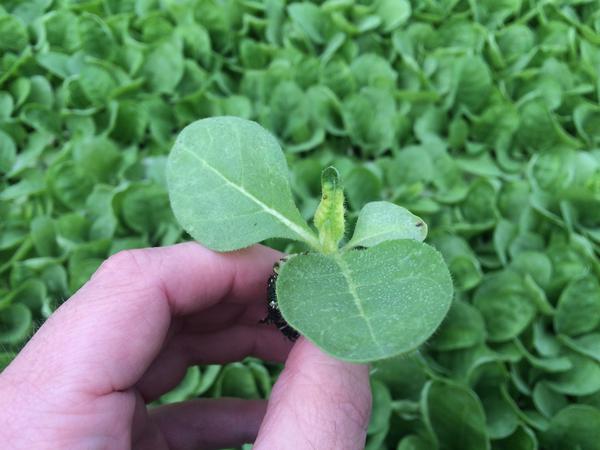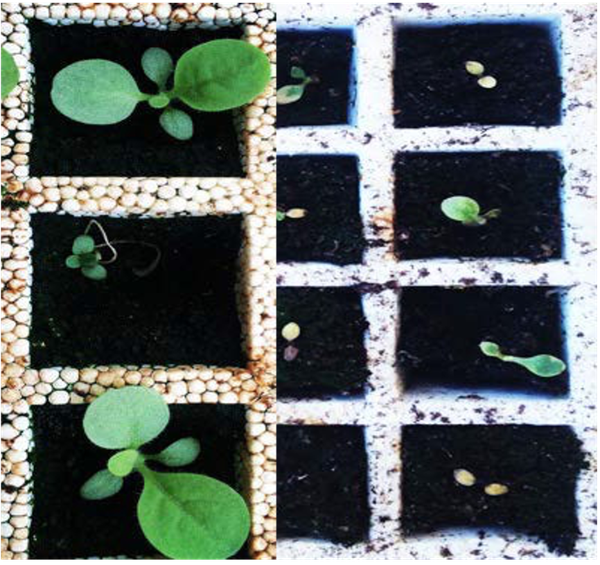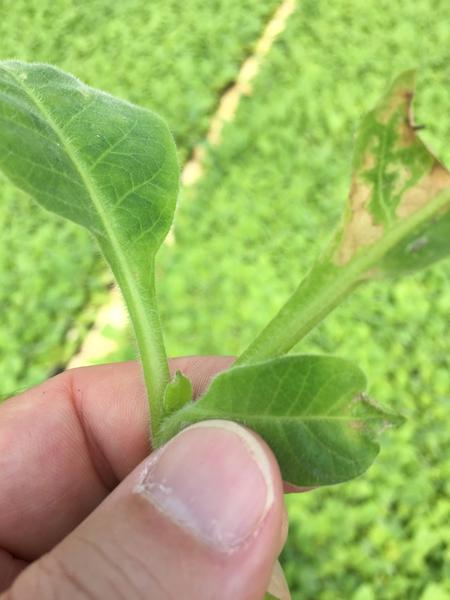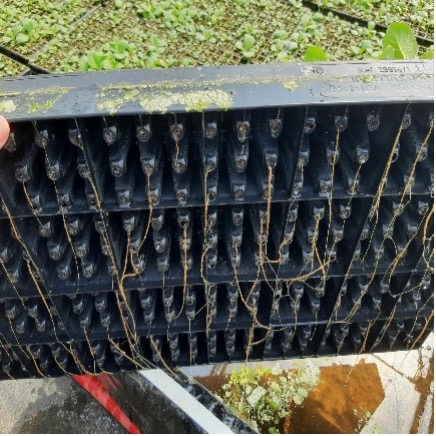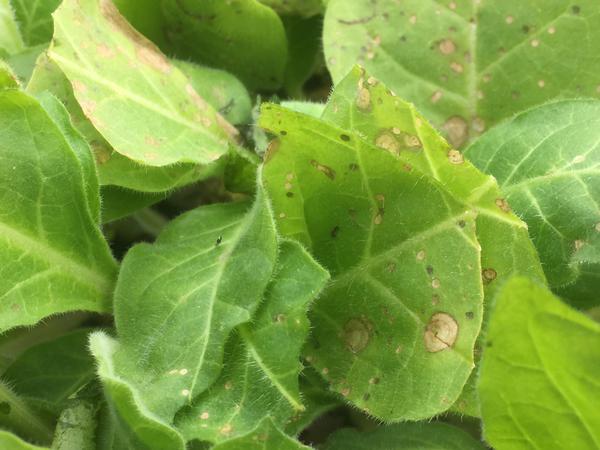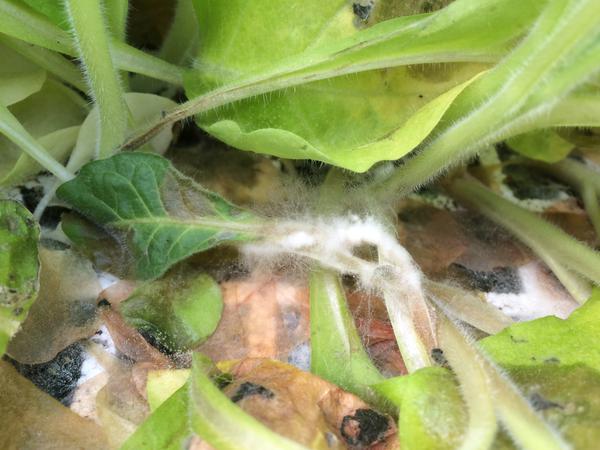Sanitation Practices
Greenhouse
- Hand remove all weeds prior to seeding.
- Do not apply herbicide in greenhouse!
- Remove any debris that may house insects (plants, soil, or bark).
- Avoid storing plants or food products near greenhouses to avoid insect and rodent movement to seedlings.
Trays
- Thoroughly remove all soilless media and plant debris immediately after transplanting.
- Steam at 176°F for 30 minutes.
Mower
Thoroughly rinse with at least 10% household bleach solution for at least one minute prior to each clipping and when transitioning between greenhouses.
Source Water Solution Analysis
- Analyze water to monitor pH, bicarbonates, and trace elements. Sample with a well-rinsed 16-fl.oz drink bottle. Run water source several minutes before sampling. Sample results can indicate when to reduce excessive bicarbonate concentration with sulfuric acid.
Germination Temperature
- Optimum daytime: 86°F
- Optimum nighttime: 68°F
- Fluctuate temperatures between day and night to break seed dormancy.
- Reduce nighttime temperature to 55°F–60°F after stand establishment (14–20 days after seeding).
- Seed trays when five-day forecast predicts bright, sunny days.
- Cold-injured seedlings (Figure 1) will recover with addition of warm air.
Fertilizer Management
- Use 2-1-2 or 3-1-3 ratio fertilizers (for example, 20-10-20 or 16-5-16).
Nitrogen (N)
- Add 100–150 ppm 7 to 10 days AFTER seeding. This will reduce soluble salts injury potential and spiral root frequency (Figure 2).
- Add an additional 100–125 ppm four weeks after seeding. Total N for seedling production = 250 ppm.
- Maintain 125 ppm N if using an injector.
Phosphorus (P) and Potassium (K)
- 2-1-2 or 3-1-3 ratio fertilizers provide sufficient P and K when targeted N rate is achieved.
- Excessive P can cause leggy or spindly transplants.
- P deficiency (Figure 3) is rare when recommended fertilizers are used.
Calcium (Ca)
- Sufficient Ca should be included in commercial growing media and float bed source water.
- Add 5 oz gypsum/100 gal of float water prior to seeding if Ca is a limiting factor.
- For deficiency (Figure 4), apply 3.51 oz of calcium nitrate/100 gal of water overhead or to float water. Either will provide 50 ppm Ca and 40 ppm N.
Magnesium (Mg) and Sulfur (S)
- Use standard fertilizers to supply sufficient Mg and S. For Mg and S deficiency, add Epsom salts at a rate of 4 oz/100 gal of float water.
Boron (B)
- Use fertilizer with 0.02% B to ensure a trace amount of B.
- Float bed concentration should be 1–2 ppm. Less than 0.5 ppm is considered low. To correct, add no more than 0.2 oz Borax/100 gal of float water; this will supply 1.5 ppm B.
- Collect a water sample prior to seeding to determine B levels.
- Remember B is toxic to plants when concentration exceeds 2 ppm (Figure 5)! Add total source water B concentration to fertilizer B to determine total B concentration in the float bed. Collect a diagnostic float water sample after fertilizer addition to analyze B concentration.
Common Calculations
Gallons of Water in a Floatbed
- Length (ft) × width (ft) × depth (ft) × 7.48 gal/cubic foot = gal of water/bed
Fertilizer Application
- Desired ppm of nutrient ÷ (% concentration in fertilizer × 0.75) = oz of fertilizer/100 gal
Disease Control
- Sanitize and ventilate the greenhouse to control disease.
- Dispose of old and diseased trays. Steam-sanitize trays (176°F for 30 min) between each use to prevent Pythium root rot (Figure 6) and Rhizoctonia diseases.
- Store trays in a cool, dry, enclosed area when not in use.
Pythium Root Rot: Terramaster® 4EC
- Preventative rate = 1.4 fl. oz/100 gal of float water.
- Curative rate = 1.4 fl. oz/100 gal of float water.
- Mix Terramaster® well throughout float bed. Root shedding is expected. Apply within eight weeks after seeding at three-week intervals for sequential applications. Maximum use of Terramaster is 3.8 fl. oz/season.
Target Spot (Figure 7): Quadris® Flowable
- 0.14 fl. oz/1,000 square feet. Use at least 5 gal of water/1,000 square feet. Coverage is critical! Apply only once prior to transplanting.
Black Root Rot (Figure 8)/Tobacco Mosaic Virus/Collar Rot (Figure 9) / Bacterial Soft Rot:
- No chemical control is available or recommended; discard infected trays and seedlings.
Seedling Growth Management
- Clip properly to ensure plant uniformity, hardiness, and maximum usable seedlings.
- Clip plants 1.5 inches above bud when plants are 2–2.5 inches above tray.
- Clipping five times improves viability by increasing stem diameter and reducing stem elongation. After the fifth clipping, seedlings are only being “held” until transplanting.
- Discard plant clippings at least 100 yards from greenhouse for sanitation.
Insect Control
Aphid, Flea Beetle, or Caterpillar Management in the Greenhouse:
- Orthene® 97 = 0.375 oz in 3 gal of water/1,000 square feet during seedling production.
- Multiple formulations; always check the label.
Aphid, Flea Beetle, or Thrips Management in Greenhouse within Five Days Before Transplanting for Field Protection:
- Imidacloprid (Admire® Pro) = 0.6–1.2 fl. oz/1,000. Transplant within five days of treatment, check label for further field protection.
- Thiamethoxam (Platinum® 75 SG) = 0.17–0.43 oz/1,000 plants. Transplant within two days of treatment. Apply Admire® Pro and Platinum® overtop of seedlings and rinse thoroughly and immediately to ensure media wash-in.
- These materials can also provide control of soil insects such as wireworms at the high rates.
- Refer to the North Carolina Agricultural Chemicals Manual for soil insect control recommendations.
Estimated EC Meter Reading Examples
| 100 ppm N | 150 ppm N | |
|---|---|---|
| Ultrasol 16-5-16 | 0.80 mS/cm | 1.20 mS/cm |
| Ultrasol 20-10-20 | 0.65 mS/cm | 0.98 mS/cm |
*Correcting bicarbonates with acid will elevate EC reading.
*Many greenhouse fertilizer labels contain estimated EC readings.
Publication date: Feb. 26, 2020
Reviewed/Revised: Dec. 20, 2024
AG-870
Recommendations for the use of agricultural chemicals are included in this publication as a convenience to the reader. The use of brand names and any mention or listing of commercial products or services in this publication does not imply endorsement by NC State University or N.C. A&T State University nor discrimination against similar products or services not mentioned. Individuals who use agricultural chemicals are responsible for ensuring that the intended use complies with current regulations and conforms to the product label. Be sure to obtain current information about usage regulations and examine a current product label before applying any chemical. For assistance, contact your local N.C. Cooperative Extension county center.
N.C. Cooperative Extension prohibits discrimination and harassment regardless of age, color, disability, family and marital status, gender identity, national origin, political beliefs, race, religion, sex (including pregnancy), sexual orientation and veteran status.

